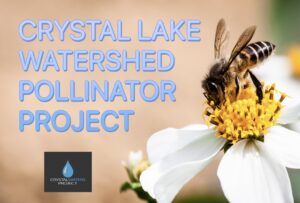
In late March of 2022, Crystal Waters was awarded a Lawns to Legumes grant by the Minnesota Boards of Water and Soil Resources. The process was finalized in May and the work began. Since then, CWP has planted, or assisted with planting, five pollinator projects. Learn more about them and see photos of the installations in the article below.
Jones Park
Located south of the dog park, this hidden gem is a peaceful spot for connecting with nature. County Ditch 56 flows nearby and this stormwater pond is surrounded by trees, shrubs and grasses. Birds are abundant and a mowed path makes it easy to walk the perimeter.The pollinator project at this location created long strips of native species on both sides of the peninsula that juts out into the pond. After removing sod, laying weed suppression mats and mulch, about 500 plugs of native grasses and flowers were planted. These included Indian Grass, Joe Pye Weed, Swamp Milkweed, Big Bluestem, and Blazing Stars.
Nearly 1,000 square feet of garden were created, and in future years, this should be a spot that attracts both pollinators and visitors who want to savor time in a natural environment.
Robinson Park
Already the site of a flourishing pollinator garden, the Lawns to Legumes grant allowed the lakeshore planting at Robinson Park to be expanded by about 320 square feet. Nearly 200 plant plugs were added. These deep-rooted native species will stabilize the soil, minimizing erosion.
If you haven’t toured the park recently, take a walk along the paved path and watch for the abundant pollinators visiting the gardens. Listen to the sounds of the lake and the birds and soak in the beauty of majestic oaks.
LCWM High School
LCWM High School is the site of a stormwater holding pond. Many native species could already be found there, but the Lawns to Legumes grant allowed this area to be greatly expanded. About 6,000 square of meadow was seeded with native species that will encourage soil health, attract pollinators and provide a space for learning about the environment.
Twelve dogwoods were planted around the perimeter of the pond, which will provide year-round habitat and vibrant spring and fall color. In addition, a variety of deciduous trees were planted. Thirty-two in total, they are all pollinated either by wind or insects.
In years to come, this area will provide both a woodland and a meadow and will be home to all sorts of birds, insects and small mammals. The deep roots of the trees and plants will stabilize the soil and absorb huge amounts of rainwater and snow melt, reducing the amount of water that enters the stormwater system.
Murray-Davis
Al Davis and Marge Murray-Davis undertook two large projects on two adjoining parcels of land. They ended up restoring about 6,000 square feet near the shoreline, adding hundreds of native pollinators. Their efforts will stabilize the shoreline, reducing erosion both from the lake and from the adjacent hillside. It will also provide habitat for a wide range of creatures, attract pollinators, and create a colorful, aesthetically-pleasing landscape.
Thompson Hobart
Adjacent to a lush natural shoreline. Bob Hobart and Teri Thompson-Hobart installed a tiered shoreline garden using wattles and native species that will put down deep roots, holding the soil in place. In all, they planted about 110 plugs and potted flowers, creating a colorful scene that can be appreciated both from the lake and from their backyard. Especially interesting is the retaining wall they built from downed trees.